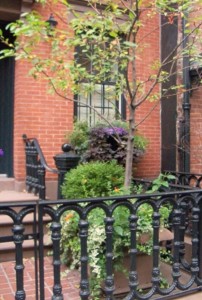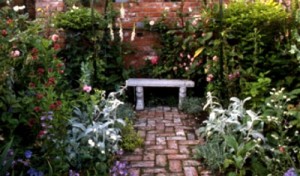





The Town Garden
Because of pressure of space the smallest area of garden in a town is worth making the most of. It is not many years ago since winter smogs so blackened leaves and depressed plants and people alike that small town gardens were hardly thought worthwhile. Reduction of atmospheric pollution has changed all that so much so that many town gardens enjoy conditions which a country garden might well envy. Any large conurbation raises ambient temperatures and reduces humidity— and while the latter is a horticultural misfortune, on a small scale it is very easily remedied. But the warmer temperatures, especially in winter, are invaluable.

An Outdoor Room
Sun is bound to be at a premium because of the likelihood of surrounding high walls and other buildings, and this is bound to dictate much of the design of the garden. Desirable though it is, even if a town garden enjoys virtually no sun at all it is enormously worthwhile to make an attractive garden in the space that is available. Think of it as a cool evening sitting-room for use after work. To be able to be outside at the end of a stifling summer’s day is the restorative experience that every city dweller needs. It is sad so few have the opportunity.
 It is likely, therefore, that the small size of town gardens makes it necessary that every inch is used to advantage. It is usually best considered as a terrace or ‘patio’ from which there is no way out, in other words an enclosed courtyard, where the ‘views’ have to be contrived by the use of interesting plants on the walls or carefully arranged objects. An illusion of space can be contrived by a wall-painting or white-painted trellis built in false perspective. Wherever possible a view from a window or a door should appear to go somewhere or end in a definite way. A wall-mask dripping water into a shell is an unoriginal, but always delightful eye catcher.
It is likely, therefore, that the small size of town gardens makes it necessary that every inch is used to advantage. It is usually best considered as a terrace or ‘patio’ from which there is no way out, in other words an enclosed courtyard, where the ‘views’ have to be contrived by the use of interesting plants on the walls or carefully arranged objects. An illusion of space can be contrived by a wall-painting or white-painted trellis built in false perspective. Wherever possible a view from a window or a door should appear to go somewhere or end in a definite way. A wall-mask dripping water into a shell is an unoriginal, but always delightful eye catcher.
Town dwellers invariably pine for grass, but it is a great mistake to try to maintain a necessarily minute lawn in a town garden. Good lawn grasses are just not adapted to shade and invariably die out: annual meadow grass comes in which is incapable of remaining green throughout the year and the result is a mess. There is, then, no alternative to hard surfaces of one sort or another—paving and brick where people are to walk or sit, cobbles or loose gravel where contrast is required to the planted areas around.
Planting
Good permanent planting is vital to give texture and body throughout the year. Leaf shape and general outline are often more important than beauty of flower. But the two are not mutually exclusive.
Camellias are marvellous town plants in all but the coldest spots. Their lustrous evergreen leaves, tidy habit, heavy autumn buds full of pregnant potential opening to luxurious flowers, make them invaluable. They make good wall plants (back branches tied to the support) and exist in a range of colours from white to dark blood red.
Their only reservation is an insistence on acid soil and if this is not natural (although many old town soils become so) a raised bed of imported lime-free soil plus peat is a good investment. The modern Camellia x williamsii hybrids are particularly lovely, the singles having a delicate dog-rose grace. Camellias will take full shade and still flower: only really hot, dry spots should be avoided.
Climbers
There are very few self-clinging climbers. Virginia creeper in one of its forms attains the greatest height (when it really gets rather unmanageable) but has the disadvantage of being deciduous. This is true, also, of the otherwise lovely climbing Hydrangea petiolaris. The most valuable plant for town garden walls (and not only these) is ivy in all its many forms; green, gold, variegated, big leaved or small leaved. It is worth mentioning, too, that contrary to popular belief, ivy does not harm sound walls at all — though it will get into cracks and under slates as will any climber given the chance.
All other climbers will need support round which they can twine (summer jasmine and wisteria) or can hold onto (vines and clematis) and this should be done as permanently as possible. A difficulty occurs here with white or colour-washed walls, although in dark courtyards the whiteness does help to lighten the effect, for when repainting is necessary the climbers are in the way. One answer is not to worry but just to let the plants furnish the ‘room’, another is to have wires strung from upright battens which are hinged at the base; the whole section can then be swung out and down, the plant stems being flexible enough to accept this.
Covering the Ground
At the foot of the climbers a miscellany of plants, shrubby and herbaceous will follow. Again the ideal is complete cover — soil is a medium for growing plants in, not an aesthetic experience in its own right. Summer colour is best added by containers of annuals, including scented things such as tobacco plants, petunias and stocks with the more unusual pelargoniums (which are marvellous town-garden plants: in London they often survive the winter) and fuschias.
Sadly very few roses are good town garden plants when mixed with other things. They become leggy and look dreadful in winter. Climbing roses too are apt to get quite out of reach and are a considerable effort to train and prune. An exception is the lovely, thornless Rosa banksiae. It is a plant for a south-facing, two- or three-storey house and gives cascades of small double yellow flowers in May and June.
Copyright © www.100flowers.win Botanic Garden All Rights Reserved